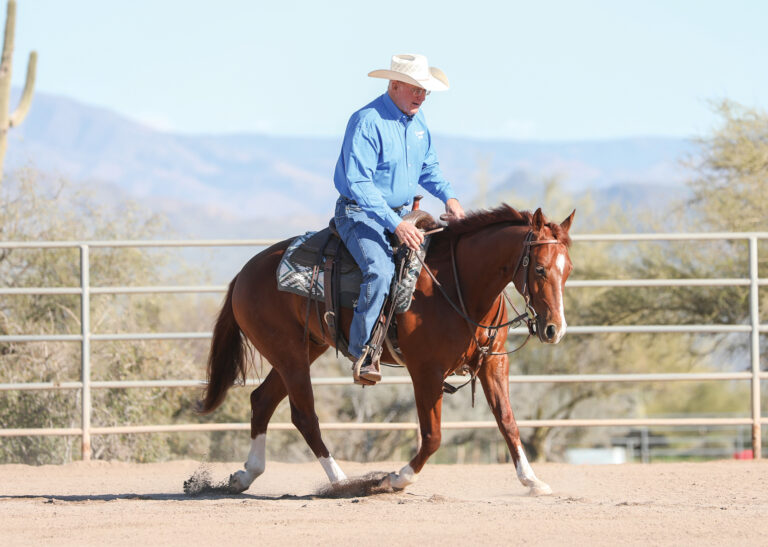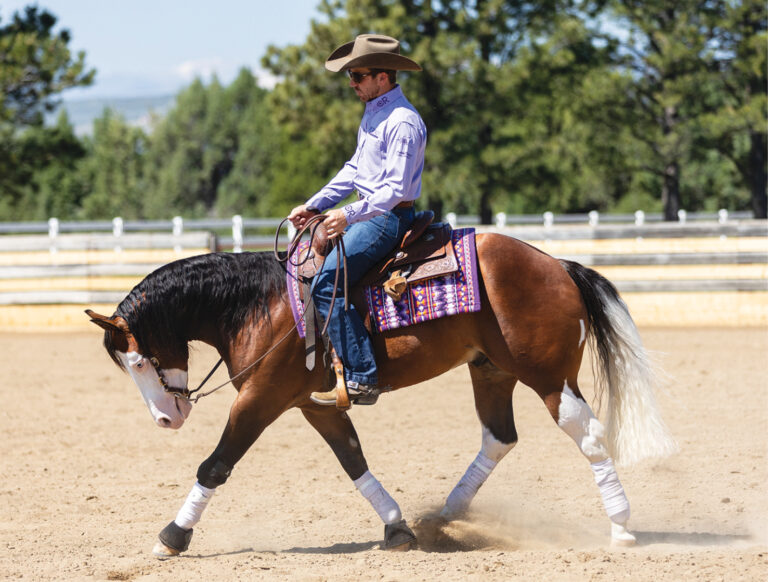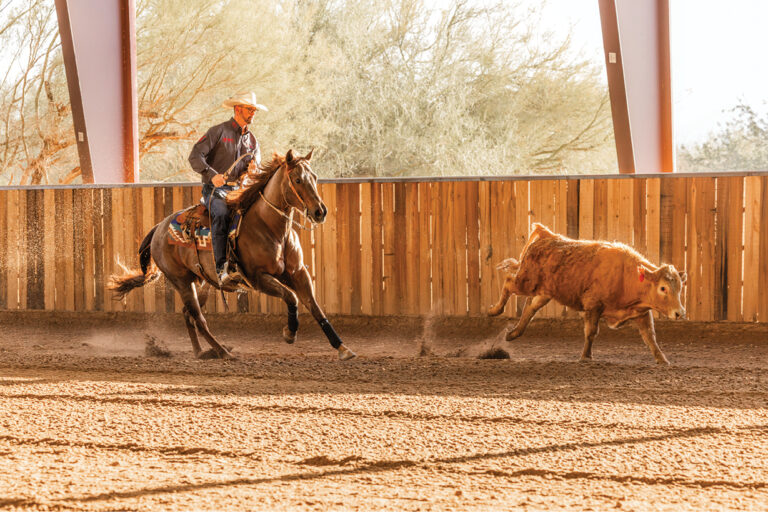Practicing for roping, sorting, working cow horse, or any cattle class is challenging without, well, cattle. That was one reason Bill Riel and fiancée Emma Reichert decided to introduce cows to their small horse farm in Mechanicville, New York. Riel team roped, Reichert competed in breakaway roping, and their one boarder was learning to box and sort cattle. So expanding the hobby farm to include about a dozen head of cattle just seemed to make sense, and as a bonus provided the opportunity for additional income through beef sales.
[READ: DESENSITIZE YOUR HORSE TO CATTLE]
Success with cattle, as with any livestock, starts with planning. That includes breed selection, fencing, and developing an understanding of the basic needs of the species. Here, you’ll find advice for choosing a breed suited for your goals, purchasing your animals, selecting fencing and housing, and providing care—all information that will help you in your plan to bring cattle to your horse barn.
What Type of Cattle?
There are more than 80 breeds of cattle readily available in the U.S., each developed for a different purpose. Most have their own registry and website, where you can research breed characteristics to see how they might fit your farm plans.
Ashley Wright of the Cochise County Cooperative Extension in Willcox, Arizona, says how you intend to use the cattle is the most important factor when deciding which breed to buy. The breeds most commonly used for beef, dairy, roping, or other cattle events differ significantly, she notes.
“If you’re looking to raise your own beef, you’ll want to consider breeds such as Angus, Hereford, Charolais, or Simmental,” she recommends. “Corriente cattle are the most popular breed for roping steers, while breeds such as Holstein, Jersey, Brown Swiss, or Guernsey are common dairy breeds.”
For working cow horse and cutting events, Brahma cross and Charolais are popular choices.
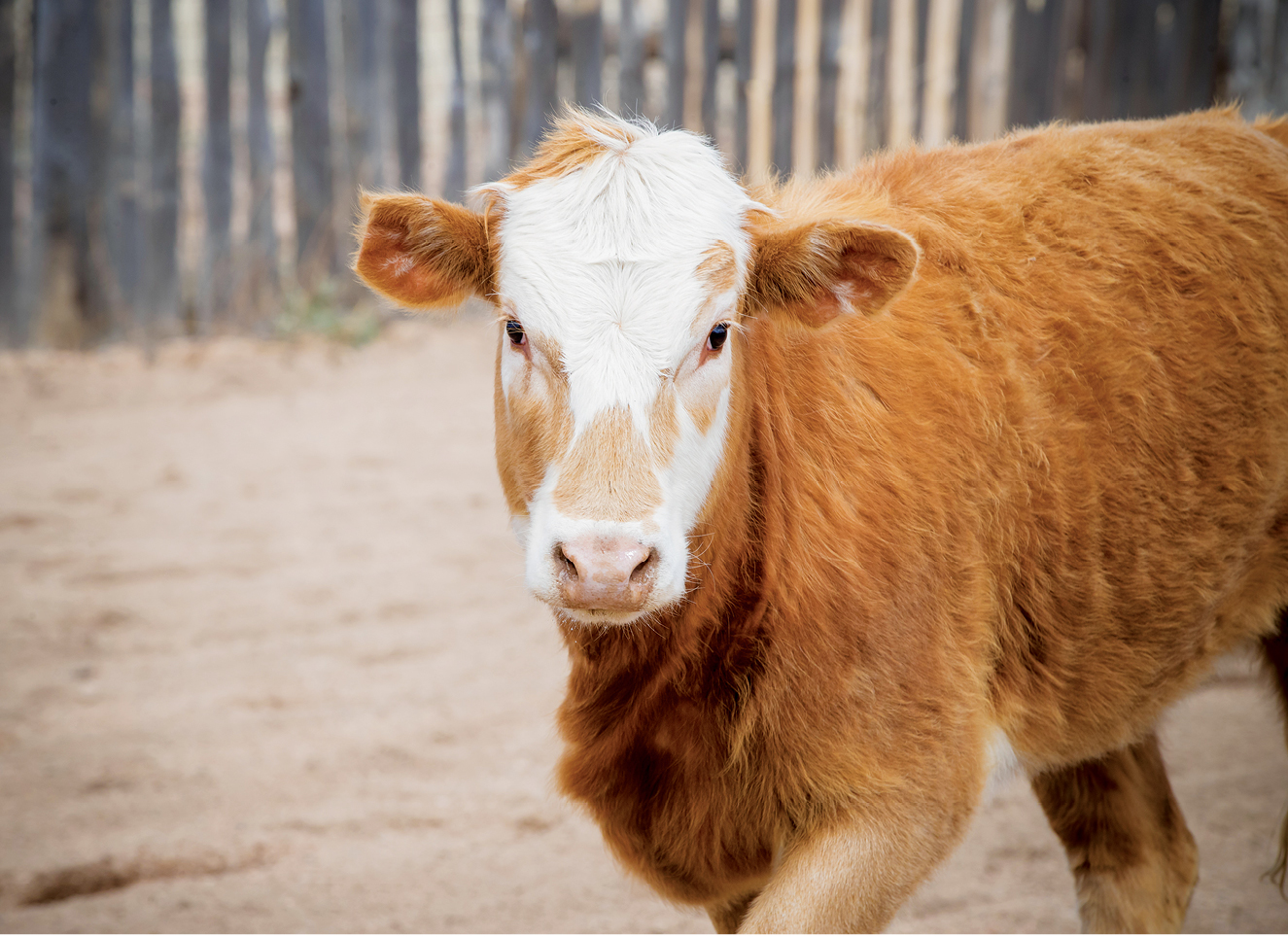
As to how many head to acquire, Wright points out that cattle, like horses, are herd animals and do better in groups of at least two or three for companionship and social-behavior needs.
Riel and Reichert started with a few heifers that were a Holstein/beef-type cross. Then they purchased a black “baldy” bull (typically a crossbred between Hereford and a solid black breed, such as Angus) to produce calves that could be raised for beef.
A few months after their initial purchase, they bought at auction four purebred calves—three Jersey and a Holstein—to use for breakaway roping practice. Their earlier-purchased crossbred heifers produced a calf each and were easily sustained on grass and hay. But the purebred Jersey and Holstein calves struggled from the day they arrived—first from scours, then from failing to bulk up. Eventually, three of those calves died.
“The Jersey thing just didn’t work for us,” Riel says. “That’s one thing you have to be prepared for—the animals that don’t survive.” He’s since purchased a Hereford and an Angus, both breeds known for producing heavier weighted cattle.
Although he originally considered practicing roping with the calves produced on his farm, that’s changed now that he sees the time and money invested in raising them.
“I’m a heeler, and I don’t want to rope down on the back legs and risk an injury,” he says, noting that you, too, may find your goals and the intended use for your cattle changing over time.
Where to Buy?
Once you decide on a breed, private sales and livestock auctions are the two main ways to acquire cattle. Private sales—purchasing directly from a cattleman—allow you the opportunity to see how the cattle behave in their home environment, notes Wright.
“Cattle may act differently in the unfamiliar setting of a sale barn, and the comingling of animals from different operations can promote disease transmission,” she says. “Buying directly from the breeder also lets you ask questions and get more complete information about the vaccinations the cattle have received.”
Auctions are nevertheless a common way to acquire cattle, despite the challenges in learning how the calves have been initially handled. Ideally, calves purchased at auction should have had at least two rounds of vaccinations prior to being sold, says Wright.
Vaccines should include a seven- or eight-way mixture that covers clostridial and viral respiratory diseases. The clostridial vaccine protects against tetanus, blackleg, and similar diseases. Other vaccines in the mixture protect against infectious bovine rhinotracheitis, bovine viral diarrhea, parainfluenza virus 3, and bovine respiratory syncytial virus.

“Calves that’ve been preconditioned—that is, weaned and vaccinated—at least 21 to 45 days before coming to the sale are less likely to become ill after being sold,” Wright says. “Many sale barns will announce the calf’s preconditioning status at sale time, or you can ask while looking at the animals before the sale.”
An additional layer of protection would include screening for carriers of bovine viral diarrhea persistent infection. Calves positive for BVD-PI appear healthy but are actively shedding the BVD virus, which could infect other cattle they come into contact with, cautions Wright.
Fencing, Housing?
Cattle do well with minimal shelter in a variety of climates and temperatures, provided they have adequate feed and water, says Wright. During times of extreme heat and/or humidity, they may need access to shade trees or simple shade structures. Though extremely cold tolerant, they’ll likely also require access to a shelter during freezing rain or snow—and this is especially true for young calves.
[READ: BEST FENCING OPTIONS]
“We’ve added a lean-to off our barn so that when a heifer is close to calving, we can separate her from the others,” says Riel, noting that the structure also provides needed protection from the weather when calves are born early in the spring.
As Wright points out, beef cattle kept in large range areas are commonly contained in fences constructed of four-strand barbed wire or multi-strand, smooth, high-tensile wire, sometimes electrified.
Betsy Greene, a professor and equine extension specialist for the University of Arizona, cautions that horses and barbed wire are obviously a bad combination. The t-posts commonly used with barbed wire can also be hazardous for horses (especially if not capped on top), as can high-tensile wire.
“Horse people differ in their views of high-tensile wire for horses,” Greene observes. “One long-time horse-business owner I know had five- or six-strand high-tensile fencing. The top and middle strands were electrified in all paddocks and pastures. Still, one of her horses ran through it…and she referenced a wire cheese slicer when describing the injuries.”
Where available, snow fencing (multi-slatted barriers commonly seen along roadsides to minimize snowdrifts) can be used for cattle. Greene cautions, however, that cows, like horses, may lean on any fence that’s not electrified—or not “hot” enough. So having a strong fence is always key.
“Be aware, too, that cattle kept in smaller areas where they’re more likely to crowd fences may require some type of woven wire fence, similar to horse fence, or board/pipe fencing,” Wright adds.
The amount of land you need to run cattle depends on your management practices. Cattle kept in feeder lots and fed a grain diet need less space. Riel’s goal is to raise grass-fed beef, which requires more land for nutrition and rotation.
Riel’s original pasture for his first six cattle was a few acres in size. Over the course of the first year, he steadily expanded the pasture to 15 acres. Eventually, he plans to have 50 acres fenced off for grazing.
Notes on Basic Care
In many ways, cattle require less maintenance than horses. They live completely outside (no stall cleaning) and don’t need as much routine health care. But, as Riel and Reichert have learned, their herd is not at all what you’d call “hands-off.”
“Every animal adds almost double the work,” Riel says, “especially in the harsh winter conditions when temperatures drop below zero. I can’t simply count heads from the house. I’ve got to go out and make sure they’re all OK.”
Read “The Cattle Health Handbook” by Heather Smith Thomas.
Products we feature have been selected by our editorial staff. If you make a purchase using the links included, we may earn a commission. For more information click here.
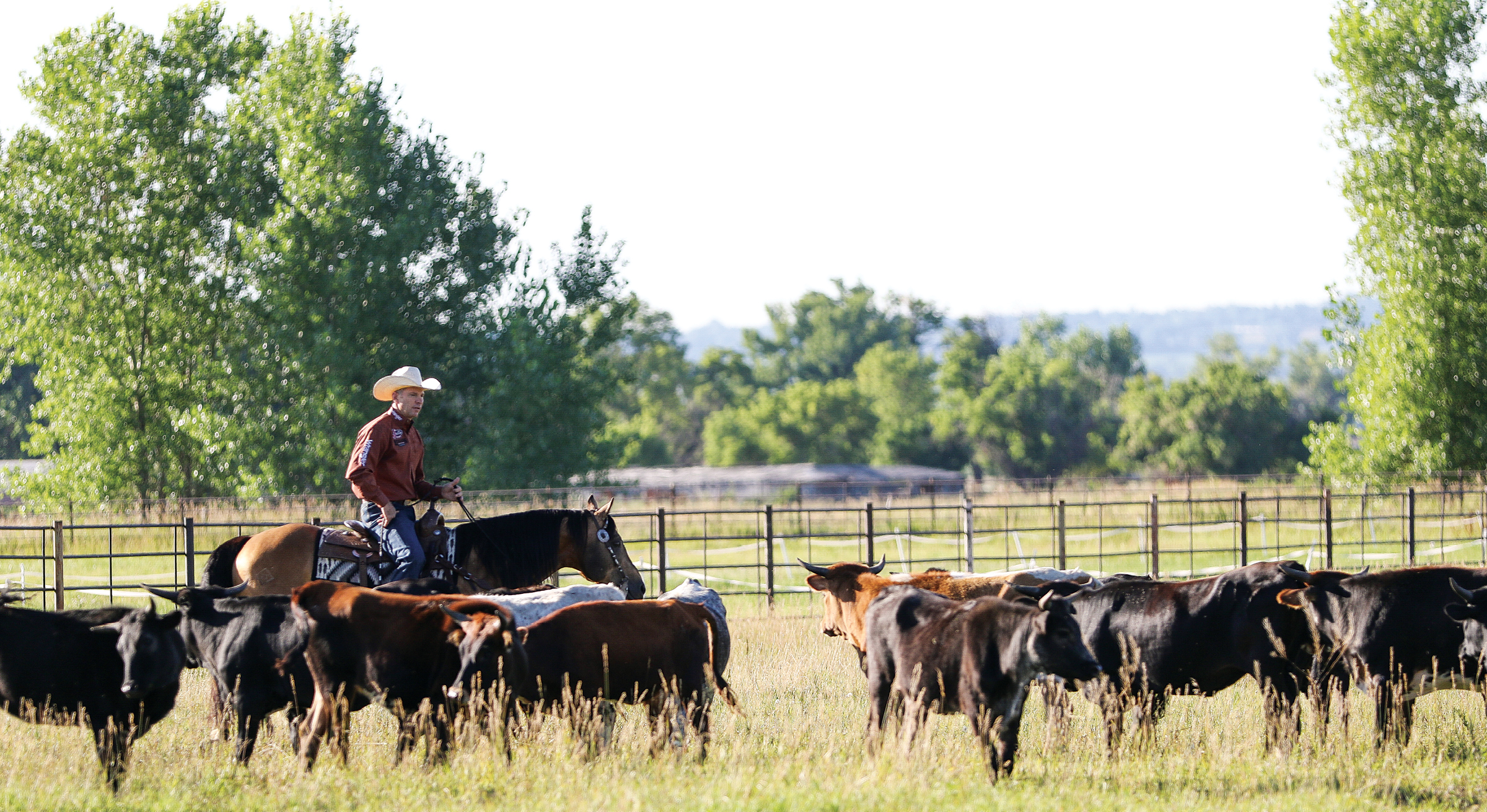
As is true for horses, cattle require an adequate, reliable water source. They consume on average 1 to 2 gallons per hundred pounds of body weight per day, depending on environmental temperatures, says Wright.
Consumption will increase significantly in hotter weather, and lactating cows will have higher water requirements as well. Extension specialist Greene adds that, again as with horses, cattle that are worked will need more water, too.
Other ongoing health needs for cattle include regular vaccinations, parasite control (generally available as a pour-on topical product), and occasional hoof care.
“We’ve done all the shots on our own and haven’t had issues requiring a veterinarian,” Riel says. “We’ve done the pour-on wormer, but now we buy the block form so they can eat it.” (Note: Some blocks designed for cattle aren’t safe for horses, so be sure to check with your veterinarian first if your horses will also have access to the block.)
Other Considerations
The couple’s horses had already been exposed to cattle through rodeos and shows, and that was a benefit. Greene says without that familiarity, horses may panic in a pasture or under saddle when they see cattle for the first time.
“If the facility includes boarding and instruction, especially to children, improper handling of cattle introduction may result in liability,” she cautions. “A new cattle pen next to the arena where youth lessons are held is probably not the best choice.”
Because non-show cattle often aren’t halter broke, Wright advises you to consider the devices you may need to restrain them safely for husbandry and veterinary care. The best solution is a squeeze chute designed specifically for immobilizing cattle. Chutes can range in price depending on the model, and there are sizes for calves up to adult cows and bulls.
“Alternatively, you could use a ‘head catch’ or locking head gate, such as what’s used on dairy operations, though this option is best for tame cattle only,” says Wright.
Livestock supply companies sell these products, but in areas where cattle are regularly used for jackpot ropings or sanctioned rodeo competitions, it’s often possible to purchase used equipment, which is more cost effective for smaller farms just getting started. Riel bought a squeeze chute from a friend who ran jackpot roping events.
Overall, “it’s certainly been a learning process,” he admits. “I spend a lot of time reading about managing the cattle and some of it has been learned through trial and error.
“But,” he adds, “it’s all been worth it.”

